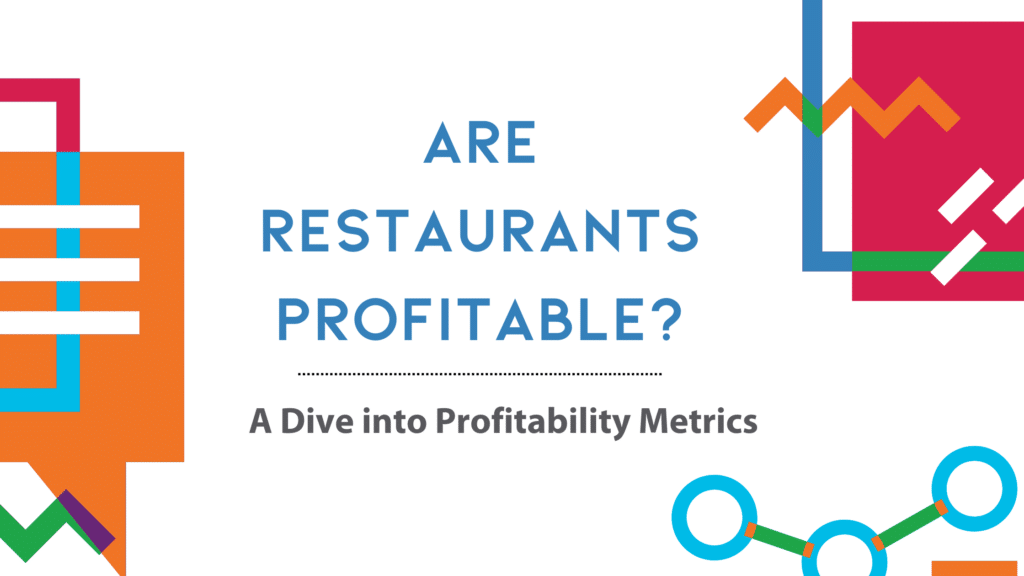Are restaurants profitable? Yes, of course, they are!
Just not your restaurant…
While we write this in jest, we don’t doubt that there have been times when you’ve felt like this is true! Indeed, there have probably been quarters and fiscal years where it actually was true.
Understanding Restaurant Profitability Factors
We bring this up not to make light of your efforts or cause you to dwell on doubt or past setbacks, but rather to encourage and reassure. Don’t allow feelings of self-doubt to overwhelm you. Virtually all restaurateurs have felt the way you do. This is a tough business! It’s highly competitive and profit margins have historically been low across the industry. If you were regularly bringing in huge profit margins, that would be truly anomalous and would not likely last. Getting by on low-profit margins is quite normal and doing so consistently really is a marker of success.
In this post, we want to pass along some basic data about the restaurant industry as well as offer some ideas and tips on what you can do to keep that stream of profitability flowing into your restaurant and maybe even increase it a little. As with all things that involve money and investing, success is not guaranteed, past performance is not an indicator of future performance, and individual results will vary. That said, we do believe that the more information you have, the better your chances will be. So even though the answer to the question “are restaurants profitable” is yes, it takes a lot of work to make them so.
Why is the profit margin in the restaurant business so low anyway?
This is a complicated financial and economic question to which we can offer up no easy answer. There are a number of factors, here are just a few to consider.
Fungibility
While everybody needs to eat, there is only so much that they’re willing or able to pay to do so under a set of circumstances before they start looking for substitutes. Economists call this phenomenon fungibility.
Imagine you owned the only restaurant in your town and had been granted a monopoly over the industry. Theoretically, you could charge as much as you wanted for your dishes and reap huge profits, but at some point, people would simply stop coming to your restaurant and start eating their own prepared meals at home. This places a natural ceiling on the prices that you can charge.
Competition
The food and beverage industry is fiercely competitive.
Say your restaurant in the theoretical situation above served a unique type of food that was a smash hit among diners who flocked to the restaurant in large numbers. You may experience huge profits in the short term, but other restaurateurs would notice this and enter the market with their own offerings, forcing you to lower prices to compete.
Fickleness
Then there’s changing tastes. A type of food or specific restaurant may enjoy huge profits during a time when it was especially popular and then fade into obscurity. Remember the cupcake fad during the late 2000s and early 2010s? During that period, an early entrant into the cupcake restaurant business could make a lot of money. Now, many of those restaurants have either seen business ebb off or have shuttered entirely.
Waste
The restaurant business is unique in that it has to tie up a lot of capital in inventory that is highly perishable, having a shelf life of weeks, days, or even just a few hours. In a restaurant, money can effectively rot away when inventory goes unused.
So are restaurants profitable? Yes. They can be, at least. There are however a lot of things that can eat into profitability. These are just four examples. If you already own a restaurant or are thinking about starting one, you’ll need to consider them and others.
What is the average profit margin of a restaurant?
Good question! It depends on the restaurant of course and the same restaurant will probably have good years and bad years. The average restaurant profit margin for the industry year over year is three to six percent. If your restaurant is falling between these two numbers on a consistent basis, you’re doing pretty well!
Is there a most profitable restaurant type?
If you’re thinking of getting into the restaurant business this is a great question to consider. The answer is: kind of. Some types of restaurants may be a bit more profitable but not by much. A couple of percentage points maybe.
A full-service restaurant, for example, may be able to charge more than a fast-casual restaurant but also has higher operating and labor costs which means that their profit margins are actually a bit lower.
A catering business may have slightly higher margins because they don’t have a dining area which means they can use a smaller space and don’t need to employ hosts or wait staff.
Bars, or restaurants that have an alcohol menu, usually bring in more money but also have more regulatory concerns.
What can I do to make my restaurant more profitable?
Quite a bit actually! Even though there is only so much money you’ll be able to charge for your food, there are ways of squeezing more productivity out of every dollar you spend by making your restaurant more efficient and reducing waste. Here are some ideas.
Labor efficiency
By this, we don’t mean pay your staff as little as possible. Quite the opposite, investing in your staff is a great way to get the most out of every dollar you spend on labor costs.
Train your staff. Make sure they’re familiar with every item on your menu. They should know which menu items might be good for people with specific dietary preferences or requirements. Teach your staff how to upsell. When a customer is making a food order, a waiter or waitress being able to tell the customer what side dishes, desserts, or wines go well with a particular dish is a tried and true method of enticing your customers to spend more. Sure, you can hire wait staff and hosts who don’t really know much and will work for cheap, but your customers will have better experiences with happier, more professional staffers who know as much as possible.
Simplify your menu
Menu engineering is a key consideration when reducing waste. Having only a few items on your menu means that you’ll be able to order fewer ingredients and this means less money tied up in inventory and less spoilage. There’s also the added benefit that your line chefs will become very good at quickly preparing those dishes with a high degree of quality.
Use technology
Whether your restaurant is a humble hot dog stand on the street corner or a classy, full-service restaurant in the heart of the hottest neighborhood, your restaurant can benefit from technology.
For one, technology can automate or streamline certain processes like inventory tracking, control, and replenishment. It can also centralize HR functions, enabling you to manage your staff from your phone or tablet. It also enables you to capture and analyze lots and lots of data about your restaurant, the people who eat there, and what their preferences are.
So is owning a restaurant profitable? Yes, it can be, though it takes lots of work to make a restaurant continuously profitable. We have the restaurant management software to help you make your restaurant as efficient, cost-effective, and profitable as it can be.





